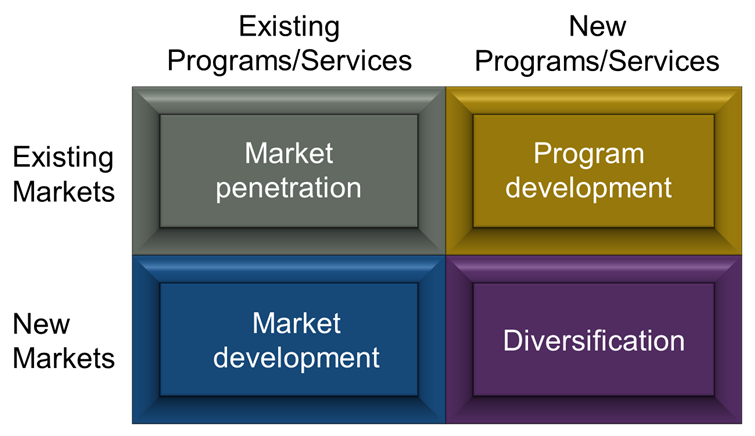enrollment
The strategic growth matrix for enrollment, and how one college generated a 19 percent gain in first-year students
This week, Ruffalo Noel Levitz released its 2015 Discounting Report for nonprofit colleges and universities across the country that are awarding their financial aid using our strategic financial aid awarding services. In this year’s report, we again see stability in overall freshman discounting, albeit it a very small marginal increase (0.1 percent). All of these campuses are using careful research to set their prices, and to anticipate families’ capacity to pay for their educations.
How do we help campuses accomplish this? The approach varies substantially from one campus to another but it always involves a mix of research and strategy. One campus we’re working with provides an interesting example. It is a private college in the Midwest that has been able to buck some of the discounting and net revenue trends in an unusual way.
This small Midwestern college increased its first-year admitted student population by 59.2 percent, growing from 611 admits in fall 2013 to 973 in fall 2014. The enrolled student population grew by 19.2 percent during the same period, increasing from 198 students to 236. This increased headcount contributed to a whopping 76.7 percent increase in net tuition revenue, and the tuition and fees discount rate dropped 10.5 percent. This college has an active athletic population, but the enrolled athletic population actually dropped by 11 students in 2014 (53 students vs. 42 students in 2013). So, why did this campus see such growth?
Growth from this campus is attributed in part to a lot of hard work and focus spent on two of the four quadrants of the strategic growth matrix (SGM):
Strategic Growth Matrix (SGM)
The SGM is a conceptual framework that shows various ways a campus can grow. The four quadrants consist of market penetration, market development, program development, and diversification.
Analyze your market penetration to make sure you are not missing qualified college students
In addition to targeting financial aid, we’ll often encourage a campus to focus additional activities on their current marketplace—the market penetration quadrant at the top left of the SGM. What are you doing within your current marketplace to ensure you aren’t missing qualified students? If you’re purchasing names to build your inquiry pool, are you buying from various sources to make sure students aren’t being missed?
Our small college mentioned above made this a point of emphasis. It reconnected with local counselors and area schools to remind those counselors that it was ready and willing to serve their students. This college also used this touchpoint with counselors to showcase new activities and initiatives on their campus. In addition, the campus undertook a self-review of its market penetration strategies. This analysis revealed that the campus had started denying admission to students it had previously admitted. The analysis also showed that these were students that the campus had previously served well. The institution concluded that it needed to “remember its roots” when it came to recruitment and admissions. Today, admissions decisions continue to be made thoughtfully to ensure the admitted students are able to find success at this campus.
Develop new markets strategically so you optimize the enrollment impact of college student recruitment resources
The second area this campus invested time, energy, and resources in was new market development. It didn’t overshoot its recruitment web by looking at markets across the country, but invested in key contiguous state markets. Market development takes time, and this campus had spent time buying names in these marketplaces in previous years. However, during this last cycle, the institution decided to travel, create programs, and recruit students from these key markets—and the extra efforts paid off. Applications, admits, and enrolled students came from these new markets because of the increased activity.
Program development and diversification
Although this campus did not focus on all four areas in the strategic growth matrix, the final two areas can also be useful for campuses in growing enrollments. Program development is a source of growth many campuses can pursue. By adding new academic or co-curricular programs, campuses can stimulate growth in their current marketplace. However, with market development, you want to research demand and growth potential of new programs so you invest wisely. Many campuses use our Academic Program Demand Analysis to guide their program expansion strategies.
The final area, diversification, isn’t typically explored by very many campuses, as it is the most expensive and requires the most thought. With diversification, a campus would consider adding a medical school, for example, which would require additional faculty, facilities, and any number of additional items to pull off such an undertaking. Again, this would be something a campus should research carefully.
Campuses can still find ways to grow even in a difficult higher education marketplace
We are in an age where turning the financial aid dial to affect enrollment is becoming more and more challenging. The small college we’ve been discussing here used a page out of the past to stimulate new growth. It penetrated its current marketplace to greater heights and encouraged activity in new markets. This is a tried and true formula that works when it is handled strategically and informed by solid data. Congrats to this campus. We’re looking forward to another successful cycle with our partnership.
What strategies for growth is your campus considering? Are you interested in exploring more options? If so, please feel free to contact us—we are visiting campuses nationwide every week and would be happy to speak with you. You can reach me by phone at 1-800-876-1117, or email me.


